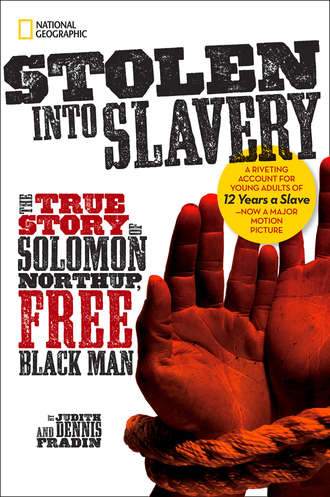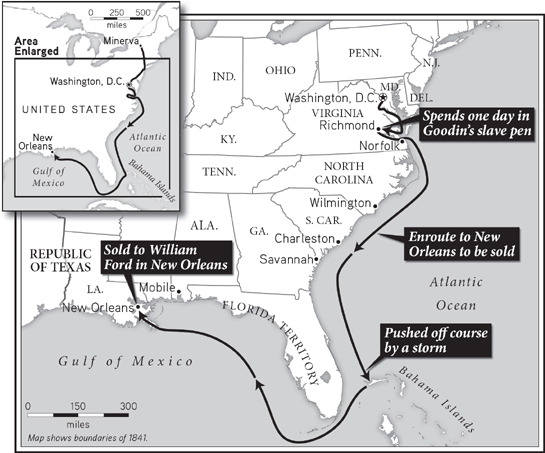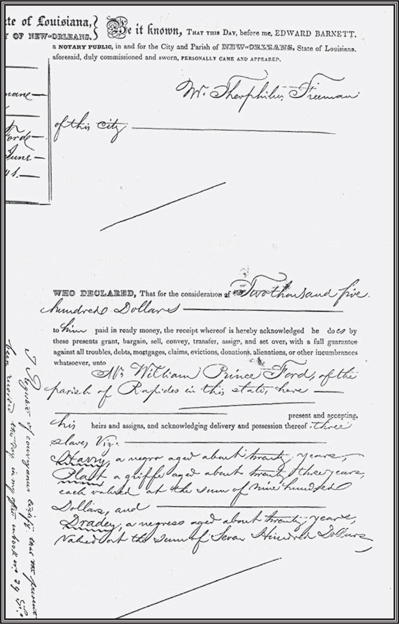
Полная версия
Stolen into Slavery: The True Story of Solomon Northup, Free Black Man

From Washington, D.C., Solomon was shipped to New Orleans, where he was purchased by William Ford. (Illustration Credits 1.9)
Solomon had befriended two fellow slaves on the Orleans with whom he had a lot in common. One of them was another free black man named Robert who had a wife and two children in Cincinnati, Ohio. Robert had been promised a job in Virginia, but upon arriving there he was kidnapped and sold to Goodin’s slave pen in Richmond.
Arthur, his other shipboard friend, was also a free black man with a family. Arthur had been a bricklayer in Norfolk, Virginia. Late one night while returning home from work through an unfamiliar neighborhood, he was attacked by a gang of white thugs who had sold him into slavery.
Solomon discussed his plan to take over the Orleans with Robert and Arthur. He pointed out that when the sailors locked the slaves in the cargo hold at night, they never did a head count to make sure everyone was present. There was a small boat on the deck of the Orleans. By hiding beneath it, Solomon could avoid being locked in the hold at night. Then, while the others slept, he would climb out from under the little boat and release Robert and Arthur from the hold.
Next, the three of them would grab the pistols and cutlass in the captain’s cabin and take the captain and crew prisoner, shooting anyone who resisted. They would then sail the ship up to New York City, where authorities were likely to sympathize with them. Solomon and his two accomplices kept their plan secret because slaves caught plotting a revolt could be put to death.
Soon after Robert and Arthur agreed to his plan, Solomon tested whether the little boat was a good hiding place. When the slaves were ordered into the hold for the night, he slipped away and hid beneath the boat. At dawn he sneaked out without anyone noticing and joined the other slaves emerging from the hold.
The three men decided to strike as soon as the Orleans departed the Bahamas. Finally, a favorable wind stirred, and the Orleans pulled up anchor and set sail. But before they could seize the vessel, Robert became ill with smallpox and died. He was buried at sea, a thousand miles from his home and family in Cincinnati. The plan for seizing control of the ship died with Robert because Solomon and Arthur could not do it by themselves.
An evening or two after Robert’s death, Solomon was resting on the deck when a sailor asked why he was so downhearted. The sailor, Englishman John Manning, seemed sympathetic, so Solomon decided to take a chance. He explained that he was a free man from New York with a wife and three children and that he had been kidnapped. Manning listened closely and then offered his help.
Before they parted, Solomon asked Manning to meet him in a front section of the ship called the forecastle at a certain time the following night, and to bring pen, ink, and paper with him. The next night Solomon once again avoided being locked in the hold by hiding under the little boat. In the middle of the night he crawled out and went to meet Manning.
When Solomon reached the forecastle, Manning motioned him to sit at a table where he had placed pen, ink, and paper. Solomon then began to do what very few slaves could do: write a letter. White Southerners feared that educated slaves might pass notes to each other and plan a big rebellion. That was why southern states had numerous laws forbidding slaves, and sometimes even free blacks, from learning how to read and write. White people who dared teach African Americans in defiance of the laws faced punishment themselves.
For example, in 1829 Georgia passed a law providing a fine of $500—about $12,000 in 2011 dollars—and possible imprisonment for any white man or woman who taught a black person—slave or free—to write. In 1830 Louisiana and North Carolina passed laws forbidding the teaching of reading and writing to slaves. The penalty for educating a slave in Louisiana was a year in prison. Two years later Alabama and Virginia enacted laws subjecting white people to a fine and a whipping if they were caught teaching blacks to read and write.
As a free black person growing up in New York, Solomon had obtained a fine education, so he could read and write very well. Sitting at the table with John Manning, he wrote a long letter to Henry B. Northup, a lawyer from Sandy Hill, New York, who was a member of the family that had owned Solomon’s forebears. In his letter Solomon said that he had been kidnapped and was headed for New Orleans aboard the Orleans. Unfortunately, he didn’t know who would buy him and where he would live, but he hoped Mr. Northup would inform his family that he was still alive and in the New Orleans area so they could track him down and rescue him.
John Manning promised to mail Solomon’s letter from the New Orleans post office. A day or two later the ship arrived at the Crescent City with its cargo of slaves. Shortly after the Orleans docked, Solomon witnessed a remarkable scene. Two men boarded the vessel and informed Arthur that he was a free man and that his kidnappers had been arrested and jailed. As he left the ship, Arthur danced about with happiness. But when Solomon looked at the crowd on the wharf, he saw no familiar faces come to liberate him.
Yet he knew he had one friend among the crew. As he left the Orleans, John Manning looked at Solomon over his shoulder. Solomon thought Manning’s glance was to let him know that he hadn’t forgotten about mailing his letter.


SHORTLY AFTER THE ORLEANS DOCKED IN NEW ORLEANS, slave dealer Theophilus Freeman arrived on board. Freeman, who did extensive business with James Birch, had bought Solomon and several other slaves aboard the ship sight unseen. Before taking this human cargo to his slave pen, he called their names and handcuffed them.
When he called out “Platt!” no one stepped forward. Pointing to Solomon, Freeman asked the captain of the Orleans, “Who shipped that nigger?”
“Birch,” replied the captain.
“Your name is Platt—you answer my description,” said Freeman, studying his list. “Why didn’t you come forward?” Solomon honestly answered that he had never been called Platt before. “Well, I will learn you your name!” said Freeman, threatening to whip Solomon if he ever again forgot that his name was Platt.
Along with the other slaves Freeman had purchased, Solomon was led to his new owner’s slave pen. A portion of the pen was a kind of showroom where people shopping for slaves came to look over the merchandise. Freeman’s number one rule was that his slaves must do their best to look “spry and smart” in order to attract buyers and fetch a good price. He even demanded that they dance for customers to show that they were happy to be slaves.
Solomon had been in Freeman’s slave pen a day or two when an elderly gentleman came in. He lived in New Orleans, the gentleman said, and he needed a coachman. Solomon very much wanted the man to buy him, because he figured that New Orleans would offer opportunities for escape. But when Freeman announced that Solomon was selling for $1,500—equal to $40,000 today—the gentleman said that was too much and backed off.
That night Solomon came down with smallpox—the disease that had claimed Robert’s life at sea. He was sent to Charity Hospital on the outskirts of New Orleans, where his condition worsened. He ran a high temperature, suffered from severe body aches, and for three days was completely blind. The doctors believed that Solomon would die, but the thought that he had to live and return to his family went round and round his feverish brain. After 16 days in the hospital he began to recover and was returned to Freeman’s slave pen.
Finally, after weeks of being offered for sale, Solomon was purchased by William Ford, a planter from central Louisiana. Solomon was in such poor condition from his bout with smallpox that his selling price dropped to $900—$600 less than what he would have sold for before he became so seriously ill. He had now been sold three times: by Brown and Hamilton to Birch, by Birch to Freeman, and then by Freeman to Ford.
Slaves generally had no last names of their own but were called by their owners’ last names. Platt Ford, as Solomon Northup was now known, was taken by boat, train, and on foot to William Ford’s plantation. The Ford property was located in the Great Pine Woods. Escape from this vast wooded wilderness in Louisiana’s Red River Valley was nearly impossible. For one thing, the area’s large swamps were home to alligators and poisonous snakes. For another, the nearest “free state”—or state that had outlawed slavery—was 500 miles away.

This is the bill of sale certifying that Theophilus Freeman sold Solomon Northup (called Platt) to William Ford. (Illustration Credits 1.11)
Solomon was put to work chopping tree trunks into logs and making piles of lumber. A skilled carpenter, he also did construction work on the Ford family’s property.
At the time, William Ford was a wealthy cotton planter who owned a number of slaves. One of them was Walton, a house slave who had lived all his life on the Ford plantation and who spoke of Mr. Ford as a child would of his father. Another was John, the Fords’ 16-year-old cook, who walked around chuckling to himself and laughing at things that no one else found funny. However, Solomon felt the most sympathy for Eliza, the young woman who had been in Birch’s slave pen with her two children. When Freeman sold Eliza to William Ford, he sold her son and daughter to other masters. Knowing that she probably would never see her children again, Eliza cried almost continuously.
Конец ознакомительного фрагмента.
Текст предоставлен ООО «ЛитРес».
Прочитайте эту книгу целиком, купив полную легальную версию на ЛитРес.
Безопасно оплатить книгу можно банковской картой Visa, MasterCard, Maestro, со счета мобильного телефона, с платежного терминала, в салоне МТС или Связной, через PayPal, WebMoney, Яндекс.Деньги, QIWI Кошелек, бонусными картами или другим удобным Вам способом.






